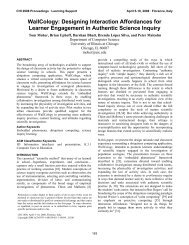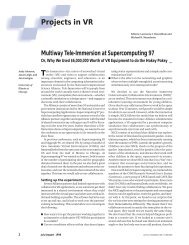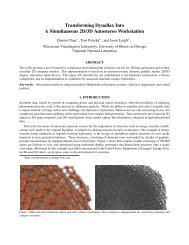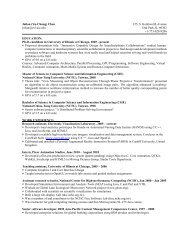The Future of the CAVE - Electronic Visualization Laboratory ...
The Future of the CAVE - Electronic Visualization Laboratory ...
The Future of the CAVE - Electronic Visualization Laboratory ...
You also want an ePaper? Increase the reach of your titles
YUMPU automatically turns print PDFs into web optimized ePapers that Google loves.
Figure 7. KAUST’s Cornea. Illustration:<br />
Mechdyne Corporation.<br />
Figure 8. Cornea upper projectors. Photo:<br />
Greg Wickham.<br />
Calit2 audio researchers designed <strong>the</strong> advanced sound system for this a six-sided virtual<br />
environment, directing Meyer Sound Lab [Meyer] engineers to nei<strong>the</strong>r obscure <strong>the</strong> visualization<br />
screens with speakers, nor place <strong>the</strong> speakers too far away, since VR screens can be somewhat<br />
acoustically opaque. To contend with <strong>the</strong>se challenges, <strong>the</strong> Cornea is equipped with 28 speakers<br />
and 4 subwo<strong>of</strong>ers outside <strong>the</strong> screens. <strong>The</strong> sound system has a sampling rate <strong>of</strong> up to 96kHz,<br />
which is more than two times <strong>the</strong> sampling quality <strong>of</strong> a compact disc (44.1kHz). A higher<br />
sampling rate means <strong>the</strong> system <strong>of</strong>fers more flexibility in terms <strong>of</strong> audio playback, and high<br />
definition performance consistent with state-<strong>of</strong>-<strong>the</strong>-art audio production techniques and<br />
equipment.<br />
Cornea makes it possible for users to record <strong>the</strong>ir VR experiences, both visually and aurally. <strong>The</strong><br />
facility can stream 32 channels <strong>of</strong> high-definition audio and video from Cornea to KAUST’s<br />
Interactive Media Room, where it can be recorded and archived. This capability provides a<br />
needed tool for scientists to collaborate with <strong>the</strong>ir counterparts at institutes that lack virtual<br />
environments. Mechdyne engineers designed and implemented this recording capability.<br />
<strong>The</strong> Cornea’s audio system is driven by custom audio switching, routing and rendering s<strong>of</strong>tware<br />
that incorporates <strong>the</strong> latest advances in realistic virtual acoustic imaging, such as air absorption,<br />
Doppler effect, source directivity, reflection/absorption simulation, and convolution<br />
reverberation. This system functions both as an audio rendering engine and as a creative sounddesign<br />
authoring tool for Cornea visual applications. KAUST scientists can create audio<br />
soundtracks that correspond to <strong>the</strong>ir 3D visual data, so a walk through a virtual architectural<br />
rendering, for example, can include <strong>the</strong> sound <strong>of</strong> one’s own voice and footsteps reverberating <strong>of</strong>f<br />
<strong>the</strong> virtual walls.<br />
KAUST has two additional SXRD-based VR facilities for virtual reality research, development,<br />
and application use. One is a 75-seat room with a 32-Megapixel/eye stereo VR screen (precisely<br />
two walls <strong>of</strong> <strong>the</strong> Cornea side-by-side, involving eight 4K projectors in a 2x2-paired layout plus a<br />
ninth projector in <strong>the</strong> middle). This multi-purpose room also features an advanced audio research<br />
capability whose description is outside <strong>the</strong> scope <strong>of</strong> this paper. <strong>The</strong> second one is a development<br />
system, <strong>the</strong> DS-1, which is one-half wall <strong>of</strong> <strong>the</strong> Cornea, used primarily by programmers.







